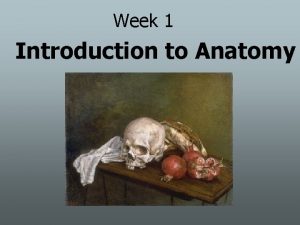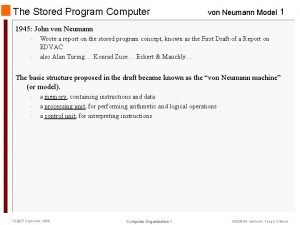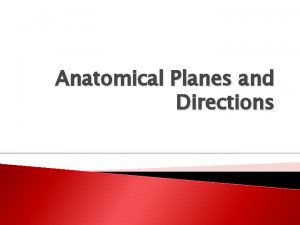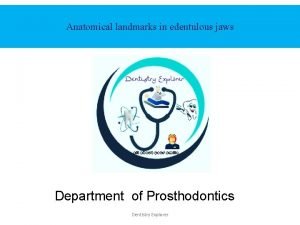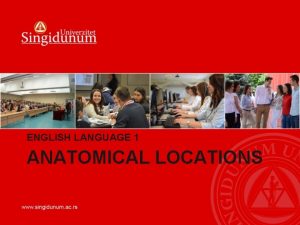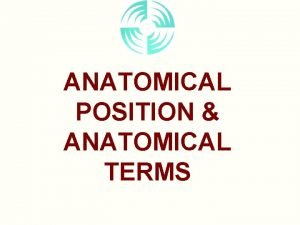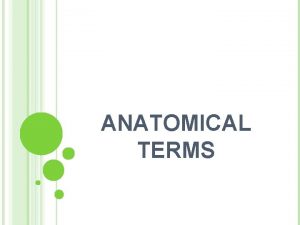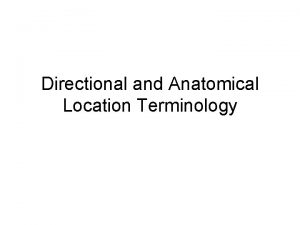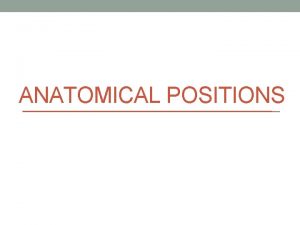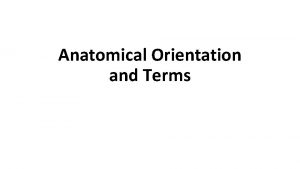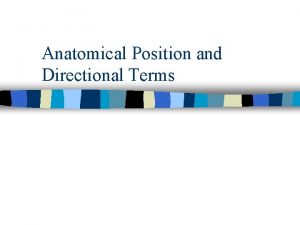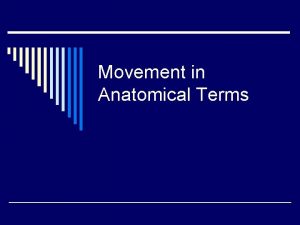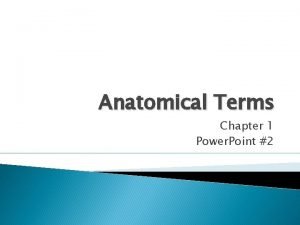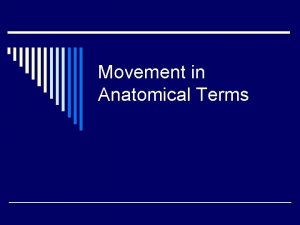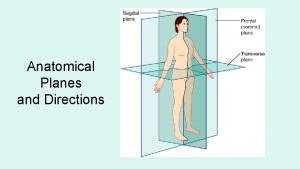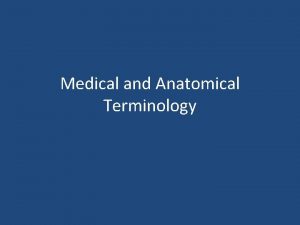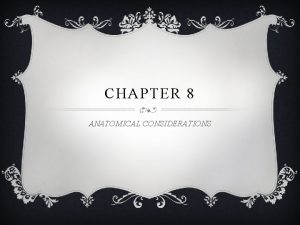Anatomical terms A General terms for locations and

















- Slides: 17

Anatomical terms A. General terms for locations and surfaces • • • 1. ventral: (L. venter = belly) away from backbone or toward front of body 2. dorsal: (L. dorsum = back) toward backbone, away from front of body 3. anterior: toward the front, or away from back. Usually used with reference to free extremities or the head, but may be used interchangeably with ventral. 4. posterior: toward the back, or away from front. Can be used interchangeably with dorsal. 5. In hands and forearms, palmar used for ventral, while dorsal retained. In feet, sole of foot called plantar, while dorsal is top of foot. 6. superficial: toward the surface 7. deep: away from surface 8. superior: upper 9. inferior: lower 10. cranial: toward head--rostral and cephalad used too 11. caudal: toward tail, away from head 12. external: toward the outer surface--used most often to describe body cavities or body wall, but sometimes used interchangeably with superficial

• • • 13. internal: toward the inner surface, interchangeable with deep 14. medial: toward the axis or midline 15. lateral: away from axis or midline 16. proximal (L. proximus = next): toward the body or toward the root of a free extremity 17. distal (distant): away from body or root of free extremity 18. central: pertaining to or situated at center 19. peripheral (L. peri = around): toward the outward surface or part. 20. buccal: pertaining to mouth or inner surface of cheeks 21. cervical: pertaining to neck 22. contralateral: opposite side 23. ipsilateral: same side 24. costal: pertaining to ribs B. Planes of Reference: • • 1. sagittal plane: vertical cut which divides body uneven into right and left halves--parallel to sagittal suture a. Medial sagittal or midsagittal or medial plane: divides body midline into left/right halves 2. frontal or coronal plane: divides body into front and back parts--parallel with coronal suture 3. transverse plane: horizontal plane dividing body into upper and lower parts


C. Descriptive terminology on bones • • • • • 1. condyle: rounded or knucklelike process (bony prominence) 2. spine: sharp projection 3. tubercle: sm. rounded projection 4. tuberosity: lg. rounded projection 5. fissure: cleft or deep groove 6. foramen: an opening or perforation in a bone or cartilage 7. groove: furrow 8. meatus: tube or passageway 9. sinus: cavity within bone 10. sulcus: groove or furrow 11. protuberance: swelling, or knoblike outgrowth D. Names of muscles 1. Geometric names--reflect shape of m. (quadratus=square) 2. General form names--gracilis (slender); digastricus (2 bellied); serratus (sawlike) 3. Location in body--temporalis (temple); intercostal (between ribs); subclavius (under clavicle) 4. Descriptive terms--major, minor, external, internal, rectus (straight), & oblique 5. Number of heads of origin (biceps, triceps) 6. Reflect attachments--sternocleidomastoid (to mastoid process of temporal bone); palatoglossus 7. Function--levator veli palatini, tensor tympani




Speech Production: An Overview • Where does speech begin? • Speech begins at the cortical level, with an idea that you want to communicate. The thought process leads to neural impulses being sent to muscles of breathing, larynx, and to the articulators. Impulses can be delivered to all musculature simultaneously, or to an individual structure. There is temporal overlap and mutual influence on the structures involved in speech. For example, we phonate at the same time the articulators are moving. Changes in resistance in the artic. system and phonatory system influence the respiratory system. Feedback as to the production of speech is important.

Some cortical areas important for motor speech • • What areas would be active if you are speaking words? What areas would be active if you were listening to words?


Speaking isn’t easy for everyone. Verbal communication involves the following. 2. Intention to verbally communicate/Conceptualization A desire to do something is developed. Thoughts/ideas/feelings emerge, as does desire to act upon them. The whole brain is involved. Linguistic, symbolic planning 3. Semantic construction of the message, recall and selection of words, and syntactic, morphological, and phonological planning occur simultaneously Motor planning 4. Gradual transformation of phonemes to a code that can be handled by the motor system occurs Motor programming 5. Selection of movements is made, as is the programming of sequential and durational aspects of movement. Becomes automatic over time. Execution 1. Muscles move

Speech-Language issues related to level of problem 1. Dementia 2. Aphasia (see next slide) 3 & 4. Apraxia 5. Dysarthria

Example of speech of person with Broca’s describing Cookie Theft picture. “uh…mother and dad…no…mother…dishes…uh…runnin over…water…and floor…and they…uh…wipin disses…and…uh…two kids…uh…stool…and cookie…cookie jar…uh…cabinet and stool…uh…tippin over…and…uh…bad…and somebody…gonna get hurt. ”

• Speech subsystems • http: //www. keepingkidshealth y. org

• For sp. production we need source of energy, and a vibrating element. 1. Primary source for energy is lower respiratory tract, esp. lungs. Conversion of air flow into sound can take place anywhere along the vocal tract (lying above the v. folds). Ex. fricative noise = constricting vocal tract producing turbulence; plosive sound = flow momentarily blocked; vibration of v. folds for voiced sounds. • Name 3 voiced phonemes. • Name 3 unvoiced sounds. 2. The primary source of vibration (creating a disturbance in the air flowing from the lungs) is the vocal folds. A noise has been generated by airflow through the closed/adducted vocal folds. Is this the speech you hear? • No, upper cavities and the articulators must shape the noise to produce sounds or phonemes, which are combined into words, sentences, etc. • Name three articulators.

• What phoneme is being produced?

2 3 4 5 8 6 1 10 9 11 12 7
 Which is dorsal side
Which is dorsal side Prontaion
Prontaion Torso organs
Torso organs Dorsal anatomy
Dorsal anatomy Like terms and unlike terms in polynomials
Like terms and unlike terms in polynomials Unlike terms
Unlike terms General and specific terms
General and specific terms Location of pride and prejudice
Location of pride and prejudice How to reorder artboards in illustrator
How to reorder artboards in illustrator Tropical wet and dry locations
Tropical wet and dry locations Neumann dst
Neumann dst Nc license and theft bureau phone number
Nc license and theft bureau phone number Longitudinal plane definition
Longitudinal plane definition Primary stress bearing area of mandible
Primary stress bearing area of mandible Formuö
Formuö Typiska drag för en novell
Typiska drag för en novell Nationell inriktning för artificiell intelligens
Nationell inriktning för artificiell intelligens Vad står k.r.å.k.a.n för
Vad står k.r.å.k.a.n för


